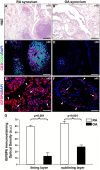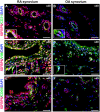Insulin-Like Growth Factor Binding Protein 6 in Rheumatoid Arthritis: A Possible Novel Chemotactic Factor?
- PMID: 28572803
- PMCID: PMC5435743
- DOI: 10.3389/fimmu.2017.00554
Insulin-Like Growth Factor Binding Protein 6 in Rheumatoid Arthritis: A Possible Novel Chemotactic Factor?
Abstract
Objectives: Immune cell migration from the bloodstream to target tissues is a hallmark of rheumatoid arthritis (RA) pathogenesis. The role of chemoattractants, mainly chemokines, and their possible targeting for therapeutic purposes have been under intense investigation over the last few years but the results were not as satisfactory as expected. The insulin-like growth factor binding protein 6 (IGFBP6), a direct inhibitor of insulin-like growth factor (IGF)-II, also exerts IGF-independent effects including tumor cell migration in vitro. We aimed to assess the expression of this protein in serum, synovial fluid, and synovial tissue (ST) of RA patients and to identify its possible chemotactic role in this disorder.
Methods: IGFBP6 was measured in RA patients and healthy donors (HD) sera by Luminex xMAP® technology and in ST of RA patients and osteoarthritis (OA) controls by immunofluorescence. The identification of circulating IGFBP6+ cells was evaluated by flow cytometry and an in vitro migration assay was arranged.
Results: We demonstrated that IGFBP6 is able to induce greater in vitro migration of RA as compared to HD and OA T lymphocytes and is overexpressed in serum and ST of RA patients. This in vitro chemotactic activity can be partially inhibited by dexamethasone.
Conclusion: Our findings suggest a pathogenic role of IGFBP6 in RA and support its possible targeting for therapeutic purposes.
Keywords: IGFBP6; cell migration; rheumatoid arthritis; synovial membrane.
Figures






Similar articles
-
CXCL16-mediated cell recruitment to rheumatoid arthritis synovial tissue and murine lymph nodes is dependent upon the MAPK pathway.Arthritis Rheum. 2006 Mar;54(3):765-78. doi: 10.1002/art.21662. Arthritis Rheum. 2006. PMID: 16508941 Free PMC article.
-
Inhibition of the insulin-like growth factor system is a potential therapy for rheumatoid arthritis.Autoimmunity. 2015 Jun;48(4):251-8. doi: 10.3109/08916934.2014.976631. Epub 2014 Oct 29. Autoimmunity. 2015. PMID: 25352179
-
CD13/aminopeptidase N-induced lymphocyte involvement in inflamed joints of patients with rheumatoid arthritis.Arthritis Rheum. 2002 Sep;46(9):2330-8. doi: 10.1002/art.10517. Arthritis Rheum. 2002. PMID: 12355480
-
Soluble receptors for tumor necrosis factor and interleukin-2 in serum and synovial fluid of patients with rheumatoid arthritis, reactive arthritis and osteoarthritis.J Rheumatol. 1995 Mar;22(3):406-12. J Rheumatol. 1995. PMID: 7783054
-
Role of the growth hormone/insulin-like growth factor-1 paracrine axis in rheumatic diseases.Semin Arthritis Rheum. 2005 Aug;35(1):24-34. doi: 10.1016/j.semarthrit.2005.03.001. Semin Arthritis Rheum. 2005. PMID: 16084221 Review.
Cited by
-
Complement system dysregulation in synovial fluid from patients with persistent inflammation following anterior cruciate ligament reconstruction surgery.J Cartil Jt Preserv. 2023 Dec;3(4):100114. doi: 10.1016/j.jcjp.2023.100114. Epub 2023 Feb 8. J Cartil Jt Preserv. 2023. PMID: 38343688 Free PMC article.
-
Comparison of the immune response during acute and chronic Staphylococcus aureus infection.PLoS One. 2018 Mar 29;13(3):e0195342. doi: 10.1371/journal.pone.0195342. eCollection 2018. PLoS One. 2018. PMID: 29596507 Free PMC article.
-
Fecal transplantation and butyrate improve neuropathic pain, modify immune cell profile, and gene expression in the PNS of obese mice.Proc Natl Acad Sci U S A. 2020 Oct 20;117(42):26482-26493. doi: 10.1073/pnas.2006065117. Epub 2020 Oct 5. Proc Natl Acad Sci U S A. 2020. PMID: 33020290 Free PMC article.
-
Adipose Tissue Dysfunction Occurs Independently of Obesity in Adipocyte-Specific Oncostatin Receptor Knockout Mice.Obesity (Silver Spring). 2018 Sep;26(9):1439-1447. doi: 10.1002/oby.22254. Obesity (Silver Spring). 2018. PMID: 30226002 Free PMC article.
-
Insulin-Like Growth Factor Binding Protein (IGFBP-6) as a Novel Regulator of Inflammatory Response in Cystic Fibrosis Airway Cells.Front Mol Biosci. 2022 Jul 12;9:905468. doi: 10.3389/fmolb.2022.905468. eCollection 2022. Front Mol Biosci. 2022. PMID: 35903151 Free PMC article.
References
LinkOut - more resources
Full Text Sources
Other Literature Sources
Miscellaneous

